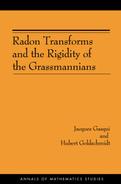CHAPTER V
THE COMPLEX QUADRIC
![]() 1. Outline
1. Outline
This chapter is devoted to the complex quadric which plays a central role in the rigidity problems. In 2![]() and 3, we describe the differential geometry of the quadric
and 3, we describe the differential geometry of the quadric ![]() viewed as a complex hypersurface of the complex projective space
viewed as a complex hypersurface of the complex projective space ![]() . We show that
. We show that ![]() is a Hermitian symmetric space and a homogeneous space of the group SO(n + 2). The involutions of the tangent spaces of
is a Hermitian symmetric space and a homogeneous space of the group SO(n + 2). The involutions of the tangent spaces of ![]() which arise from the second fundamental form of the quadric, allow us to introduce various objects and vector bundles on
which arise from the second fundamental form of the quadric, allow us to introduce various objects and vector bundles on
![]() In particular, we decompose the bundle of symmetric 2-forms on
In particular, we decompose the bundle of symmetric 2-forms on ![]() into irreducible SO(n+2)-invariant sub-bundles; one of these bundles L, which is of rank 2, was first introduced in [18].
In
into irreducible SO(n+2)-invariant sub-bundles; one of these bundles L, which is of rank 2, was first introduced in [18].
In ![]() 4, we develop the local formalism of Kahler geometry on the complex quadric following [22]; we wish to point out that auspicious
choices lead to remarkably simple formulas. The identification of the quadric
4, we develop the local formalism of Kahler geometry on the complex quadric following [22]; we wish to point out that auspicious
choices lead to remarkably simple formulas. The identification of the quadric ![]() with the Grassmannian
with the Grassmannian ![]() of oriented 2-planes in
of oriented 2-planes in ![]() given in
given in ![]() 5 allows us to relate the geometries of these two manifolds and to define the objects introduced in 3
5 allows us to relate the geometries of these two manifolds and to define the objects introduced in 3 ![]() in an intrinsic manner. In the next section, we describe the tangent spaces of various families of totally geodesic submanifolds
of
in an intrinsic manner. In the next section, we describe the tangent spaces of various families of totally geodesic submanifolds
of ![]() and present results concerning the spaces of tensors of curvature type which vanish when restricted to some of these families.
In
and present results concerning the spaces of tensors of curvature type which vanish when restricted to some of these families.
In ![]() 7, we determine explicitly the space of infinitesimal Einstein deformations of
7, we determine explicitly the space of infinitesimal Einstein deformations of ![]() and, from the point of view of harmonic analysis on homogeneous spaces, we compute the multiplicities of a class of isotypic
components of the SO(n+2)-module of complex symmetric 2-forms on
and, from the point of view of harmonic analysis on homogeneous spaces, we compute the multiplicities of a class of isotypic
components of the SO(n+2)-module of complex symmetric 2-forms on ![]() and establish properties of these components. Finally, 8 is devoted to results concerning sections of the sub-bundle
and establish properties of these components. Finally, 8 is devoted to results concerning sections of the sub-bundle ![]() in 9, we prove that the complex quadric
in 9, we prove that the complex quadric ![]() is isometric to the product of spheres S2
is isometric to the product of spheres S2 ![]() × S2.
× S2.
2. The complex quadric viewed as a symmetric space
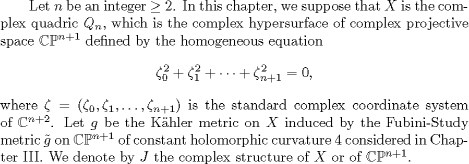
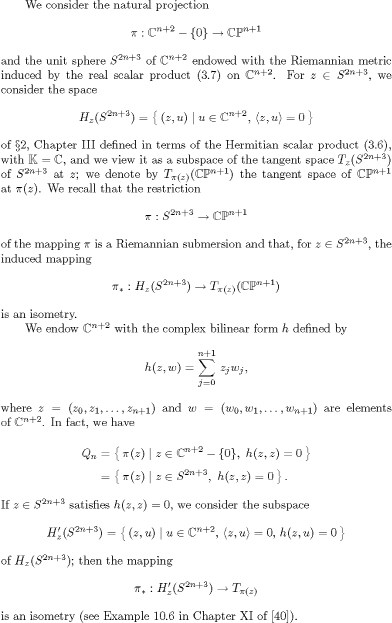
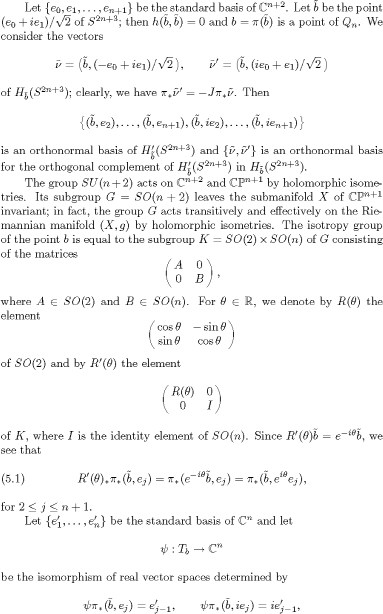
for ![]() If we identify Tb with
If we identify Tb with ![]() by means of this isomorphism
by means of this isomorphism ![]() , since
, since ![]() for
for ![]() the complex structure of Tb is the one determined by the multiplication by i on
the complex structure of Tb is the one determined by the multiplication by i on ![]() and the Kahler metric g at b is the one obtained from the standard Hermitian scalar product on
and the Kahler metric g at b is the one obtained from the standard Hermitian scalar product on ![]() given by (3.6). Moreover, by (5.1) we see that the action of the element
given by (3.6). Moreover, by (5.1) we see that the action of the element
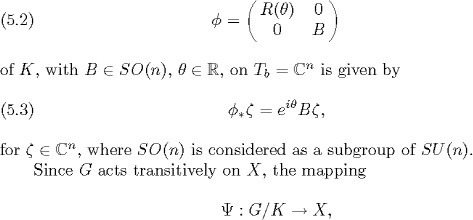
which sends the class ![]() , where
, where![]() , into the point
, into the point![]() is a diffeo-morphism compatible with the actions of G on G/K and X.
is a diffeo-morphism compatible with the actions of G on G/K and X.
The element ![]() of K belongs to the center of K and is of order 4. The element
of K belongs to the center of K and is of order 4. The element ![]() of G determines an involution
of G determines an involution![]() of G which sends G into
of G which sends G into ![]() . Then K is equal to the identity component of the set of fixed points of
. Then K is equal to the identity component of the set of fixed points of ![]() and (G,K) is a Riemannian symmetric pair. The Cartan decomposition of the Lie algebra
and (G,K) is a Riemannian symmetric pair. The Cartan decomposition of the Lie algebra ![]() of G corresponding to
of G corresponding to ![]() is
is

of ![]() , where
, where![]() are vectors of
are vectors of ![]() considered as column vectors. We identify
considered as column vectors. We identify ![]() with the tangent space of G/K at the coset of the identity element of G and also with the vector space
with the tangent space of G/K at the coset of the identity element of G and also with the vector space ![]() in particular, the matrix (5.4) of p0 is identified with the vector
in particular, the matrix (5.4) of p0 is identified with the vector ![]() )
)
If B is the Killing form of g0, the restriction to ![]() of the scalar product -B is invariant under the adjoint action of K and therefore induces a G-invariant Riemannian metric
of the scalar product -B is invariant under the adjoint action of K and therefore induces a G-invariant Riemannian metric![]() on the homogeneous space G/K. The restriction of Ad j to
on the homogeneous space G/K. The restriction of Ad j to ![]() is a K-invariant complex structure on p0 and so gives rise to a G-invariant almost complex structure on G/K. According to
Proposition 4.2 in Chapter VIII of [36], this almost complex structure is integrable and the manifold G/K, endowed with the
corresponding complex structure and the metric
is a K-invariant complex structure on p0 and so gives rise to a G-invariant almost complex structure on G/K. According to
Proposition 4.2 in Chapter VIII of [36], this almost complex structure is integrable and the manifold G/K, endowed with the
corresponding complex structure and the metric![]() , is a Hermitian symmetric space. The space G/K is of compact type and of rank 2; when n 3, it is irreducible.
, is a Hermitian symmetric space. The space G/K is of compact type and of rank 2; when n 3, it is irreducible.

Thus ![]() is a holomorphic isometry from the Hermitian symmetric space G/K, endowed with the metric (1/4n) g0, to X; henceforth, we
shall identify these two Kahler manifolds by means of this isometry. According to formula (1.65), it follows that X is an
Einstein manifold and that its Ricci tensor Ric is given by
is a holomorphic isometry from the Hermitian symmetric space G/K, endowed with the metric (1/4n) g0, to X; henceforth, we
shall identify these two Kahler manifolds by means of this isometry. According to formula (1.65), it follows that X is an
Einstein manifold and that its Ricci tensor Ric is given by
![]()
![]() 3. The complex quadric viewed as a complex hypersurface
3. The complex quadric viewed as a complex hypersurface
We begin by recalling some results of Smyth [49] (see also [21]). The second fundamental form C of the complex hypersurface
X of ![]() is a symmetric 2-form with values in the normal bundle of X in
is a symmetric 2-form with values in the normal bundle of X in ![]() . We denote by S the bundle of unit vectors of this normal bundle.
. We denote by S the bundle of unit vectors of this normal bundle.
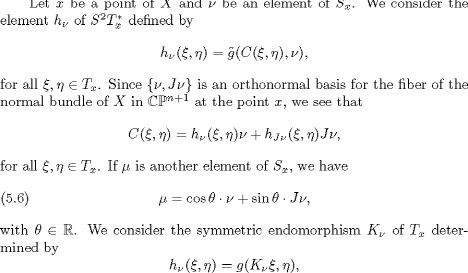
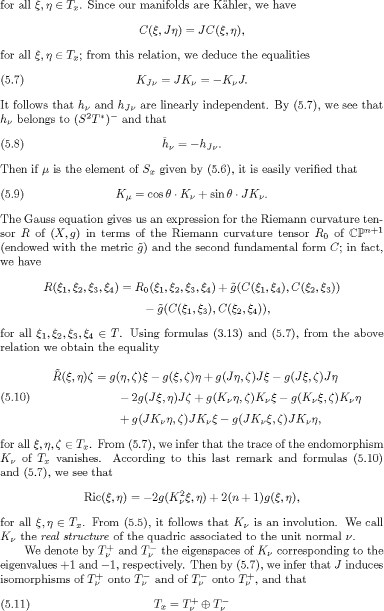
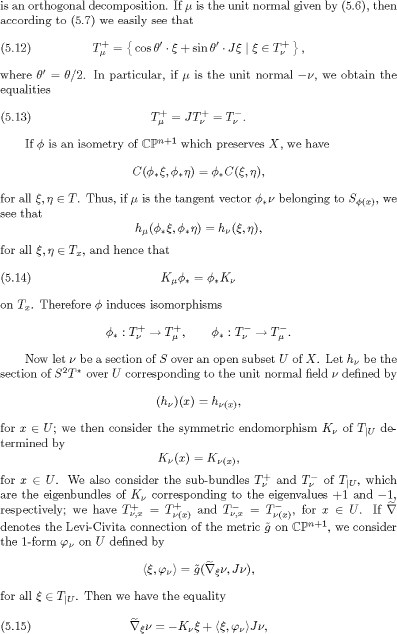
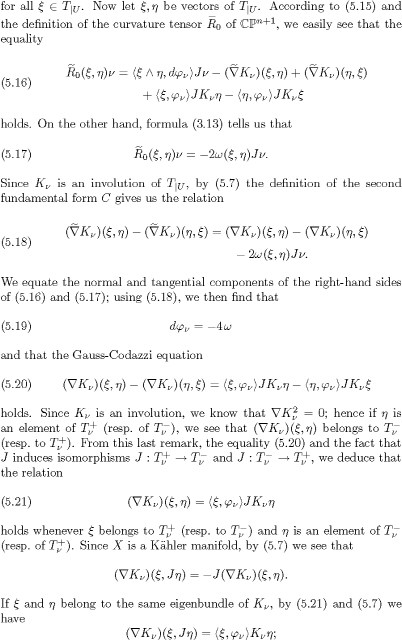
from the last two equalities, we infer that the relation (5.21) also holds in this case. Thus we have shown that
![]()
The remainder of this section is devoted to results of [21] and [23]. We consider the sub-bundle L of ![]() introduced in [18], whose fiber at
introduced in [18], whose fiber at ![]() x X is equal to
x X is equal to
![]()
C according to (5.9), ![]() if Sx, this fiber Lx is generated by the elements
if Sx, this fiber Lx is generated by the elements ![]() and
and ![]() and so the sub-bundle L of
and so the sub-bundle L of ![]() is of rank 2. We denote by
is of rank 2. We denote by ![]() the orthogonal complement of L in
the orthogonal complement of L in![]() By (5.8), we see that L is stable under the endomorphism (1.68) of
By (5.8), we see that L is stable under the endomorphism (1.68) of![]() since the automorphism J of T is an isometry, the orthogonal complement
since the automorphism J of T is an isometry, the orthogonal complement![]() of L in
of L in ![]() is also stable under this endomorphism. We denote by L, L
is also stable under this endomorphism. We denote by L, L![]() and
and ![]() the eigenbundles corresponding to the eigenvalues +i and -i of the endomorphism of
the eigenbundles corresponding to the eigenvalues +i and -i of the endomorphism of ![]() induced by the mapping (1.68). In fact, we have the equalities
induced by the mapping (1.68). In fact, we have the equalities
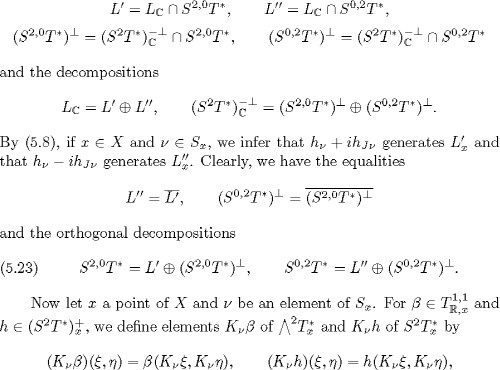
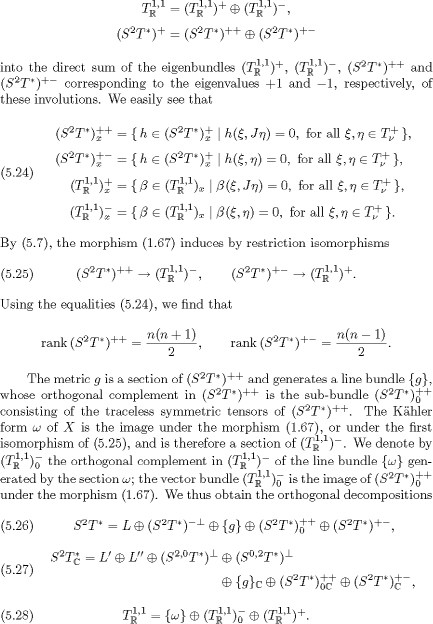
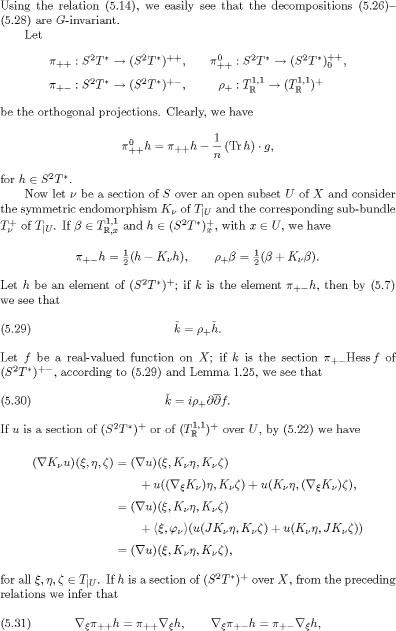

for all G and ![]() moreover
moreover![]() preserves the submanifold X of
preserves the submanifold X of ![]() The group of isometries of X generated by
The group of isometries of X generated by ![]() , which is of order 2, acts freely on X and we may therefore consider the Riemannian manifold
, which is of order 2, acts freely on X and we may therefore consider the Riemannian manifold ![]() with the metric gY induced by g, and the natural projection
with the metric gY induced by g, and the natural projection ![]() , which is a two-fold covering. By (5.33), we see that the action of the group G on X passes to the quotient Y ; in fact,
the group G acts transitively on Y . If
, which is a two-fold covering. By (5.33), we see that the action of the group G on X passes to the quotient Y ; in fact,
the group G acts transitively on Y . If ![]() is the subgroup of O(n+2)
is the subgroup of O(n+2)

where ![]() it is easily verified that the isotropy group of the point
it is easily verified that the isotropy group of the point![]() is equal to the subgroup
is equal to the subgroup ![]() of G. We know that
of G. We know that ![]() is a symmetric space of compact type of rank 2, which we may identify with Y by means of the isometry
is a symmetric space of compact type of rank 2, which we may identify with Y by means of the isometry
![]()
sending ![]() into the point
into the point![]() for G. Then by (5.33), we see that the projection
for G. Then by (5.33), we see that the projection ![]() is identified with the natural submersion
is identified with the natural submersion ![]() of symmetric spaces.
of symmetric spaces.
Clearly, we have
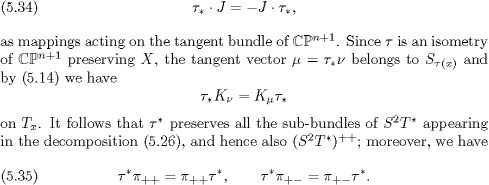
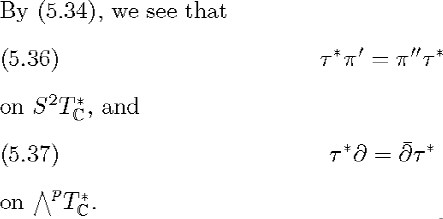

4. Local Kähler geometry of the complex quadric
We now introduce the formalism of Kahler geometry on the complex quadric X = ![]() with n 2, developed in [22, 4].
with n 2, developed in [22, 4].
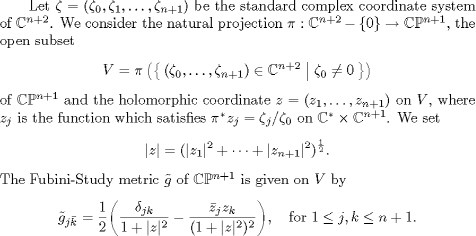
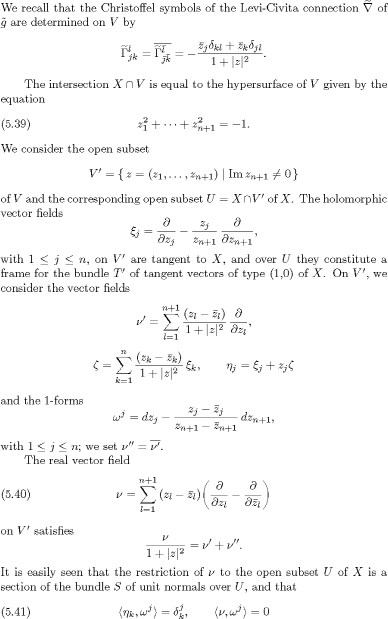
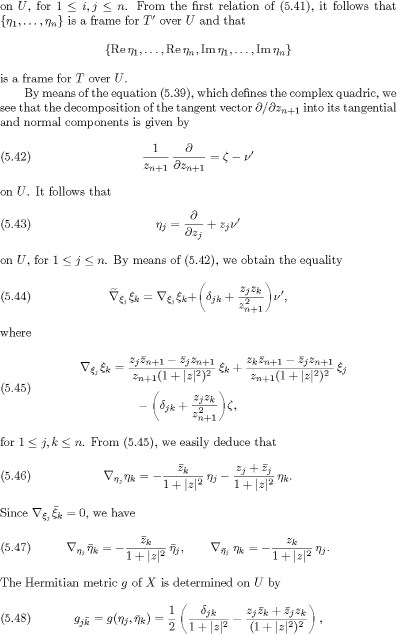

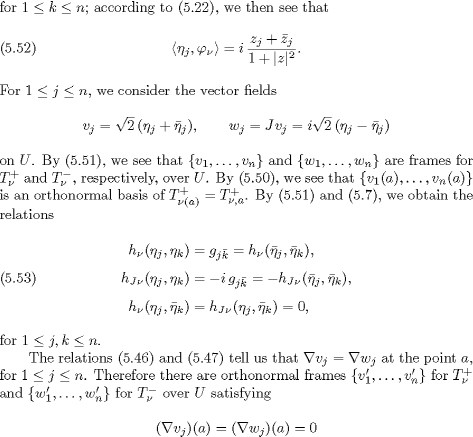
and ![]() for 1 j n. Thus since the group G = SO(n + 2) acts transitively on X, if x is a given point of X, from the preceding remark
and (5.14) we infer that there exist a section
for 1 j n. Thus since the group G = SO(n + 2) acts transitively on X, if x is a given point of X, from the preceding remark
and (5.14) we infer that there exist a section ![]() of S over a neighborhood
of S over a neighborhood ![]() of x and an orthonormal frame
of x and an orthonormal frame ![]() for the vector bundle
for the vector bundle ![]() over
over ![]() satisfying
satisfying ![]() for 1 j n.
for 1 j n.
If a is the point ![]() of S2n+3, then we note that (a) = a; moreover,
of S2n+3, then we note that (a) = a; moreover,
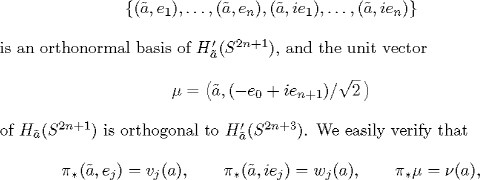
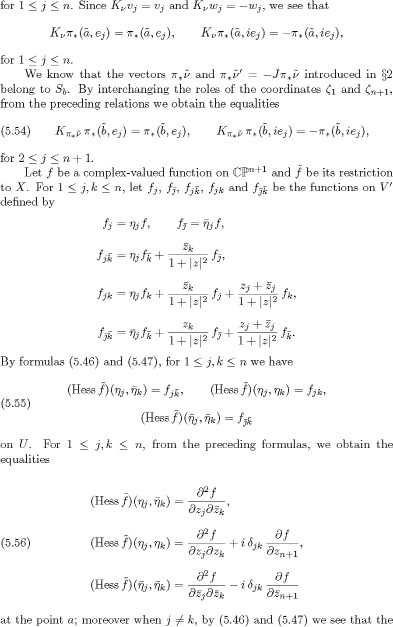
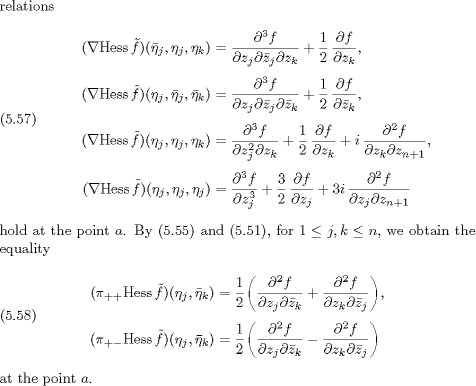
![]() 5. The complex quadric and the real Grassmannians
5. The complex quadric and the real Grassmannians
We also consider ![]() as the standard basis of
as the standard basis of ![]() . We consider the real Grassmannian
. We consider the real Grassmannian ![]() of oriented 2-planes in
of oriented 2-planes in ![]() which is a homogeneous space of G = SO(n + 2), endowed with the Riemannian metric
which is a homogeneous space of G = SO(n + 2), endowed with the Riemannian metric ![]() defined in 1, Chapter IV and denoted there by g; we also consider the homogeneous vector bundles V and W over G
defined in 1, Chapter IV and denoted there by g; we also consider the homogeneous vector bundles V and W over G![]()
We define an almost complex structure J on ![]() as follows. If x
as follows. If x![]() and
and ![]() is a positively oriented orthonormal basis of the oriented 2-plane Vx, the endomorphism J of Vx, determined by
is a positively oriented orthonormal basis of the oriented 2-plane Vx, the endomorphism J of Vx, determined by
![]()
is independent of the choice of basis of Vx and we have J2 = -id. Clearly, the almost complex structure J of ![]() , which is equal to
, which is equal to ![]() id on the tangent space (
id on the tangent space (![]() of is invariant under the group G. Since
of is invariant under the group G. Since ![]() ,n4.2 in Chapter VIII of [36], this almost complex structure J is integrable and the manifold
,n4.2 in Chapter VIII of [36], this almost complex structure J is integrable and the manifold ![]() endowed with the corresponding complex structure and the metric
endowed with the corresponding complex structure and the metric ![]() is a Hermitian symmetric space.
is a Hermitian symmetric space.
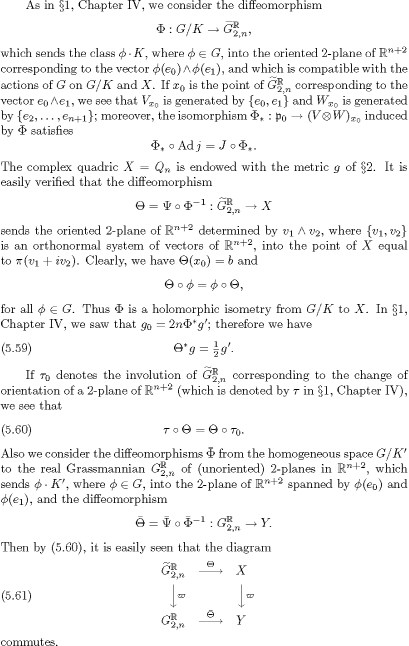
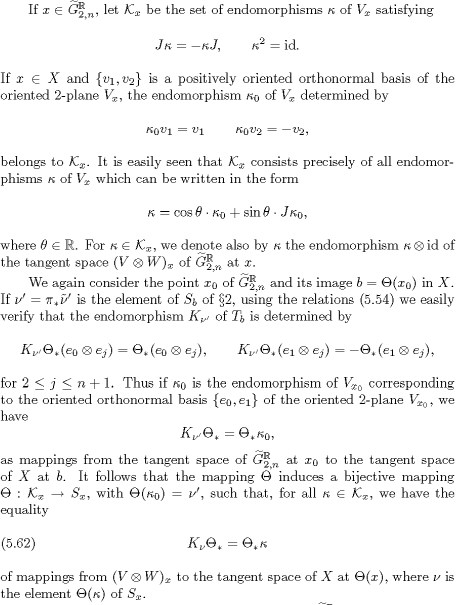
![]()
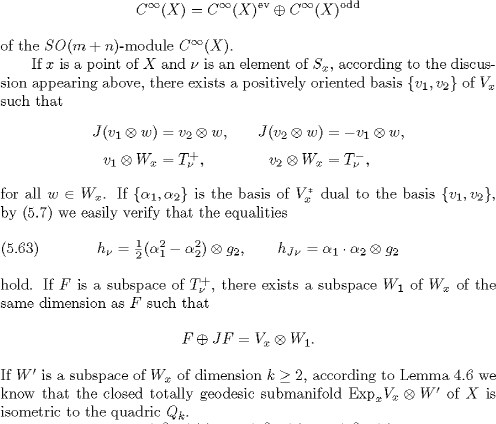
The sub-bundles ![]() and (S2T)+- of
and (S2T)+- of![]() can be defined directly in terms of the intrinsic structure of the real Grassmannian
can be defined directly in terms of the intrinsic structure of the real Grassmannian ![]() without having recourse to the imbedding of X as a complex hypersurface of
without having recourse to the imbedding of X as a complex hypersurface of ![]() by
by
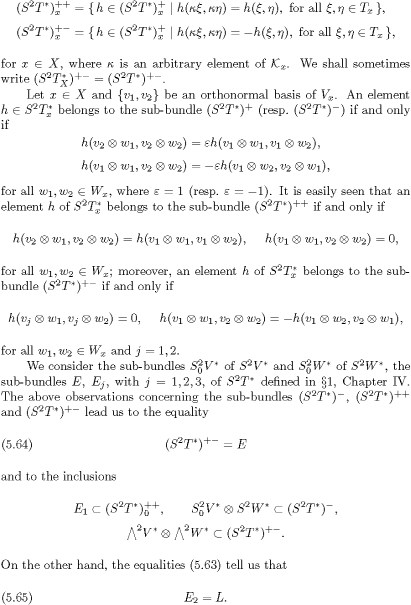
From the above inclusions, the relations (5.64) and (5.65), and the decompositions (4.6) and (5.26), we obtain the equalities

We now suppose that n is even. In![]() 1, Chapter IV, we saw that the oriented 2-plane x
1, Chapter IV, we saw that the oriented 2-plane x![]() X determines an orientation of the space Wx. Let x be a point of X and let be an element of Sx. We say that an orthonormal
basis
X determines an orientation of the space Wx. Let x be a point of X and let be an element of Sx. We say that an orthonormal
basis ![]() of
of ![]() is positively (resp. negatively) oriented if there is a positively oriented orthonormal basis {v1, v2} of Vx and a positively
(resp. negatively) oriented orthonormal basis {w1, . . . ,wn} of Wx such that
is positively (resp. negatively) oriented if there is a positively oriented orthonormal basis {v1, v2} of Vx and a positively
(resp. negatively) oriented orthonormal basis {w1, . . . ,wn} of Wx such that
![]()
for ![]() Since n is even, it is easily seen that the notions of positively and negatively oriented orthonormal bases of
Since n is even, it is easily seen that the notions of positively and negatively oriented orthonormal bases of ![]() are well-defined. Also an arbitrary orthonormal basis of
are well-defined. Also an arbitrary orthonormal basis of ![]() is either positively or negatively oriented.
is either positively or negatively oriented.
We now consider the case when n = 4. The orientations of the spaces ![]() a, with
a, with ![]() a X, and the scalar product g2 give rise to a Hodge operator
a X, and the scalar product g2 give rise to a Hodge operator
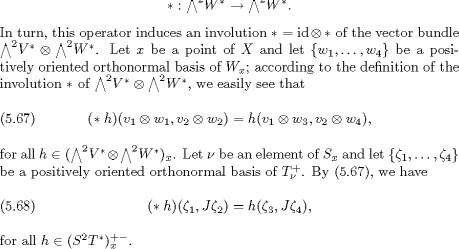
By formulas (3.6) of [21] and (5.68), we easily verify that this auto-morphism of the vector bundle ![]() is equal to the involution of the vector bundle (
is equal to the involution of the vector bundle (![]() defined in [21, 3] in terms of an appropriate orientation of the real structures of X. Thus the eigenbundles F+ and F- of
this involution of
defined in [21, 3] in terms of an appropriate orientation of the real structures of X. Thus the eigenbundles F+ and F- of
this involution of ![]() corresponding to the eigenvalues +1 and -1, which are considered in [21,
corresponding to the eigenvalues +1 and -1, which are considered in [21, ![]() 3], are equal to
3], are equal to ![]() respectively. The decomposition +
respectively. The decomposition +![]() and
and
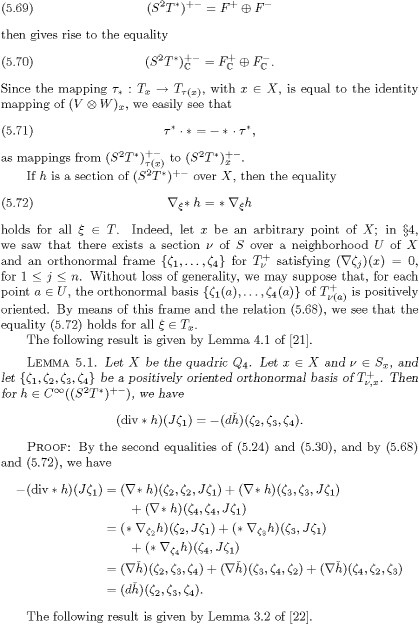
LEMMA 5.2. Let X be the quadric ![]() For all
For all ![]() we have
we have

![]() 6. Totally geodesic surfaces and the infinitesimal orbit of the curvature
6. Totally geodesic surfaces and the infinitesimal orbit of the curvature
We begin by giving an explicit representation of the infinitesimal orbit of the curvature of the complex quadric X = ![]() with n 3.
with n 3.
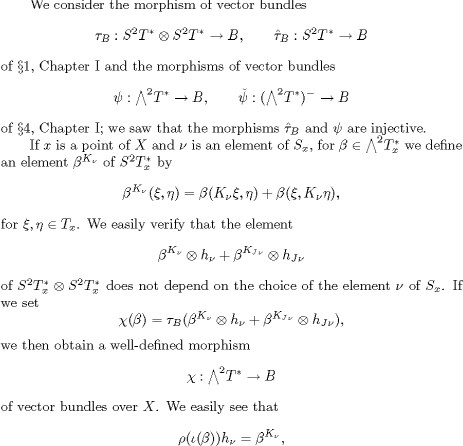
for all 2![]() From formulas (1.72) and (5.10), it follows that
From formulas (1.72) and (5.10), it follows that
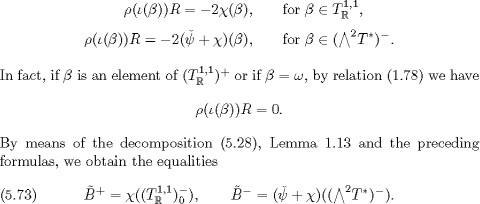
We now introduce various families of closed connected totally geodesic submanifolds of X. Let x be a point of X and be an
element of Sx. If ![]() is an orthonormal set of vectors of
is an orthonormal set of vectors of ![]() , according to formula (5.10) we see that the set ExpxF is a closed connected totally geodesic surface of X, whenever F is
the subspace of Tx generated by one of following families of vectors:
, according to formula (5.10) we see that the set ExpxF is a closed connected totally geodesic surface of X, whenever F is
the subspace of Tx generated by one of following families of vectors:
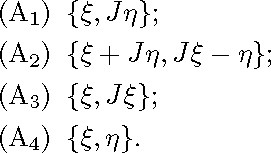
According to [10], if F is generated by the family (A2) (resp. the family (A3)) of vectors, where {, } is an orthonormal set
of vectors of ![]() the surface ExpxF is isometric to the complex projective line
the surface ExpxF is isometric to the complex projective line ![]() with its metric of constant holomorphic curvature 4 (resp. curvature 2). Moreover, if F is generated by the family (A1),
where
with its metric of constant holomorphic curvature 4 (resp. curvature 2). Moreover, if F is generated by the family (A1),
where ![]() is an orthonormal set of vectors of
is an orthonormal set of vectors of ![]() the surface ExpxF is isometric to a flat torus.
the surface ExpxF is isometric to a flat torus.
For 1 j ![]() 4, we denote by
4, we denote by ![]() the set of all closed totally geodesic surfaces of X which can be written in the form ExpxF, where F is a subspace of Tx
generated by a family of vectors of type (Aj ).
the set of all closed totally geodesic surfaces of X which can be written in the form ExpxF, where F is a subspace of Tx
generated by a family of vectors of type (Aj ).
According to 5![]() , there exists a unit vector v of Vx such that an arbitrary submanifold Z belonging to the family
, there exists a unit vector v of Vx such that an arbitrary submanifold Z belonging to the family ![]() can be written in the form Expx
can be written in the form Expx![]() where
where ![]() is a two-dimensional subspace of Wx. We consider the Riemannian metric
is a two-dimensional subspace of Wx. We consider the Riemannian metric ![]() on the Grassmannian
on the Grassmannian ![]() defined in Chapter IV; by Lemma 4.6 and the relation (5.59), we see that the submani-fold Z is isometric to the Grassmannian
defined in Chapter IV; by Lemma 4.6 and the relation (5.59), we see that the submani-fold Z is isometric to the Grassmannian
![]() endowed with the Riemannian metric
endowed with the Riemannian metric ![]() Therefore such a submanifold Z is isometric to a sphere of constant curvature 2 (see also [10]); moreover, by Lemma 4.6 we
also see that the image of Z under the mapping
Therefore such a submanifold Z is isometric to a sphere of constant curvature 2 (see also [10]); moreover, by Lemma 4.6 we
also see that the image of Z under the mapping ![]() is a closed totally geodesic surface of Y isometric to the real projective plane endowed with its metric of constant curvature
2.
is a closed totally geodesic surface of Y isometric to the real projective plane endowed with its metric of constant curvature
2.

according to (5.10) we also see that the set ExpxF is a closed connected totally geodesic surface of X. Moreover, according
to [10] this surface is isometric to a sphere of constant curvature 2/5. We denote by ![]() F5,the set of all such closed totally geodesic surfaces of X.
F5,the set of all such closed totally geodesic surfaces of X.
If ![]() is an orthonormal set of vectors of
is an orthonormal set of vectors of ![]() and if F is the subspace of Tx generated by the vectors
and if F is the subspace of Tx generated by the vectors
![]()
according to (5.10) we see that the set ExpxF is a closed connected totally geodesic surface of X. Moreover, according to
[10] this surface is isometric to the real projective plane ![]() of constant curvature 1. Clearly such submanifolds of X only occur when n 4. We denote by
of constant curvature 1. Clearly such submanifolds of X only occur when n 4. We denote by ![]() the set of all such closed totally geodesic surfaces of X.
the set of all such closed totally geodesic surfaces of X.
If ![]() is an orthonormal set of vectors of
is an orthonormal set of vectors of ![]() and if F is the subspace of Tx generated by the vectors
and if F is the subspace of Tx generated by the vectors
![]()
according to (5.10) we see that the set ExpxF is a closed connected totally geodesic submanifold of X. Moreover, this submanifold
is isometric to the complex projective plane ![]() of constant holomorphic curvature 4. Clearly such submanifolds of X only occur when n 4. We denote by
of constant holomorphic curvature 4. Clearly such submanifolds of X only occur when n 4. We denote by ![]() the set of all such closed totally geodesic submanifolds of X.
the set of all such closed totally geodesic submanifolds of X.
When n 4, clearly a surface belonging to the family F2,or to the family ![]() is contained in a closed totally geodesic submanifold of X belonging to the family F7,. In fact, the surfaces of the family
F2,(resp. the family
is contained in a closed totally geodesic submanifold of X belonging to the family F7,. In fact, the surfaces of the family
F2,(resp. the family ![]() corresp
corresp![]() ond to complex lines (resp. to linearly imbedded real projective planes) of the submanifolds of X belonging to the family
ond to complex lines (resp. to linearly imbedded real projective planes) of the submanifolds of X belonging to the family
![]() viewed as complex projective planes.
viewed as complex projective planes.
Let Z be a surface belonging to the family ![]() with 1 j 6; we may write Z = ExpxF, where F is an appropriate subspace of Tx. Clearly, this space F is contained in a subspace
of Tx which can be written in the form
with 1 j 6; we may write Z = ExpxF, where F is an appropriate subspace of Tx. Clearly, this space F is contained in a subspace
of Tx which can be written in the form ![]() where F1 is a subspace of
where F1 is a subspace of ![]() of dimension
of dimension ![]() ; we may suppose that this integer k is given by
; we may suppose that this integer k is given by

According to observations made in 5![]() , the surface Z = ExpxF is contained in a closed totally geodesic submanifold
, the surface Z = ExpxF is contained in a closed totally geodesic submanifold![]() of X isometric to the quadric
of X isometric to the quadric ![]() where W1 is a subspace of Wx of dimension k.
where W1 is a subspace of Wx of dimension k.
Let Fx be the family of all closed connected totally geodesic submani-folds of X passing through x which can be written as![]() where
where
xW1 is a subspace of Wx of dimension 3. We know that a submanifold of X belonging to F is isometric to the quadric ![]() of dimension 3.
of dimension 3.
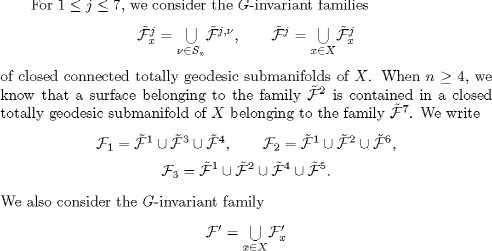
of closed connected totally geodesic submanifolds of X isometric to Q3. We have seen that a surface belonging to the family
![]() with 1 j
with 1 j ![]() 5, is contained in a closed totally geodesic submanifold of X belonging to the family F.
5, is contained in a closed totally geodesic submanifold of X belonging to the family F.
Since![]() the group G acts transitively on the set of all maximal flat totally geodesic tori of X and also on a torus belonging to
the group G acts transitively on the set of all maximal flat totally geodesic tori of X and also on a torus belonging to
![]() and since a surface of
and since a surface of ![]() is a flat 2-torus, we see that, if Z is an element of and if x is a point of Z, there exists an elemen
is a flat 2-torus, we see that, if Z is an element of and if x is a point of Z, there exists an elemen![]() t Sx and an orthonormal set of vectors
t Sx and an orthonormal set of vectors ![]()
![]()
It follows that the family F1 is equal to .
In [10], Dieng classified![]() all closed connected totally geodesic surfaces of X and proved the following:
all closed connected totally geodesic surfaces of X and proved the following:
PROPOSITION 5.3. If n![]() 3, then the family of all closed connected totally geodesic surfaces of X is equal to
3, then the family of all closed connected totally geodesic surfaces of X is equal to ![]()
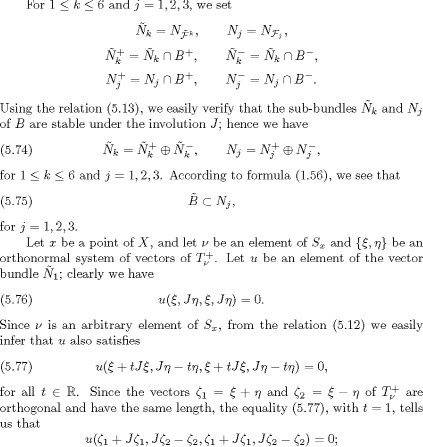
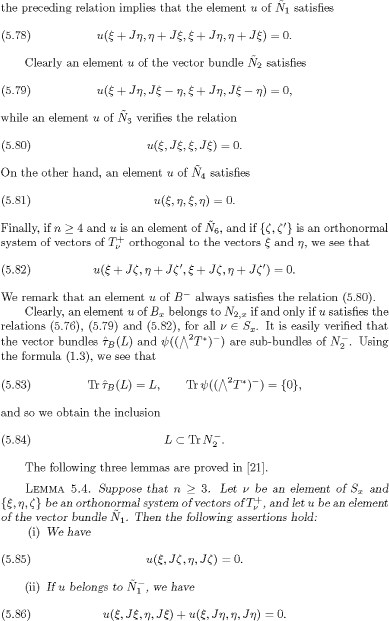
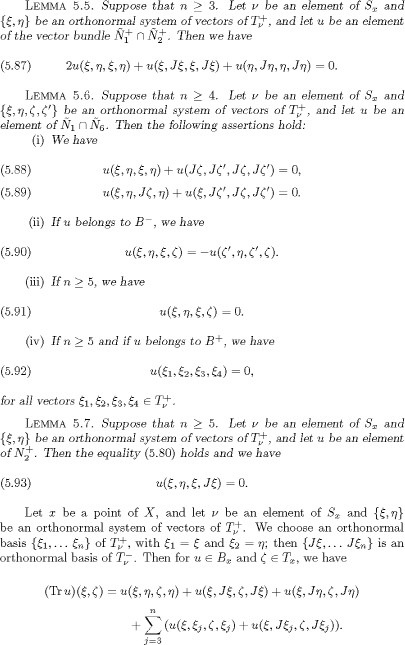
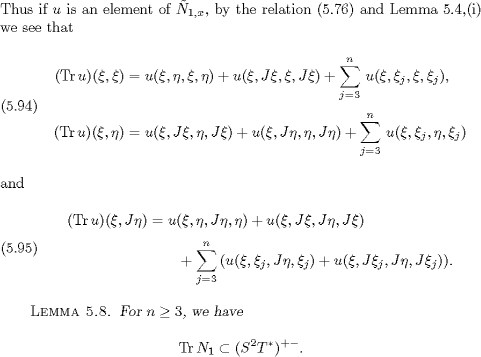
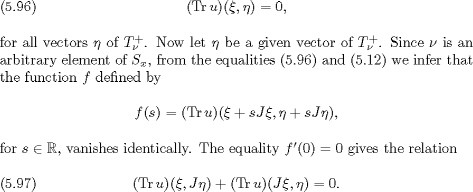
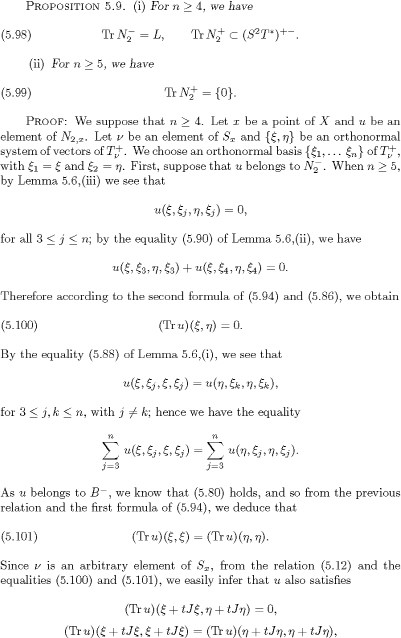

![]()
This inclusion and (5.84) give us the first relation of (5.98). Now suppose that u belongs to ![]() When n 5, by Lemma 5.7 we know that the relation (5.80) holds; then according to the first formula of (5.94) and Lemma 5.6,(iv),
we see that the expression (Tr u
When n 5, by Lemma 5.7 we know that the relation (5.80) holds; then according to the first formula of (5.94) and Lemma 5.6,(iv),
we see that the expression (Tr u![]() ) vanishes. When n = 4, according to the first formula of (5.94) and the equalities (5.87) of Lemma 5.5, we have
) vanishes. When n = 4, according to the first formula of (5.94) and the equalities (5.87) of Lemma 5.5, we have

vanishes. Hence according to (5.95), the expression (Tr u)![]() vanishes. Since Tr u belongs to
vanishes. Since Tr u belongs to ![]() we know that
we know that ![]() Thus we have proved assertion (ii).
Thus we have proved assertion (ii).
The following two propositions are direct consequences of Proposition 5.9 and the second equality of (5.74), with j = 2. In fact, Proposition 5.11 is given by Proposition 5.1 of [21].
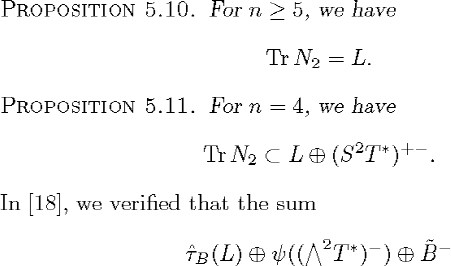
BB is direct; we also know that it is a sub-bundle of ![]() Using the relations 2 (1.79) and (5.73), in [18] we were able to determine the ranks of the vector bundles
Using the relations 2 (1.79) and (5.73), in [18] we were able to determine the ranks of the vector bundles ![]() + an
+ an![]() When n 5, by means of Lemmas 5.4–5.7 and other analogous results, in [21] we found explicit bounds for the ranks of the vector
bundles
When n 5, by means of Lemmas 5.4–5.7 and other analogous results, in [21] we found explicit bounds for the ranks of the vector
bundles ![]() and
and ![]() From these results, the relation (1.79), the second equality of (5.74) and the inclusion (5.75), with j = 2, we obtain the
following proposition (see [18,
From these results, the relation (1.79), the second equality of (5.74) and the inclusion (5.75), with j = 2, we obtain the
following proposition (see [18,![]() 5]):
5]):
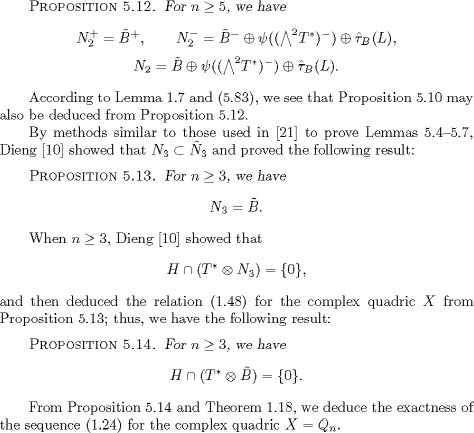
![]() 7. Multiplicities
7. Multiplicities
In this section, we shall suppose that n 3. Let g and k denote the complexifications of the Lie algebras ![]() and k0 of G = SO(n + 2) and its subgroup K, respectively. Let
and k0 of G = SO(n + 2) and its subgroup K, respectively. Let![]() and
and ![]() be the duals of the groups G and K, respectively.
be the duals of the groups G and K, respectively.

We first suppose that n = 2m, with m 2. We set ![]() We choose Weyl chambers of
We choose Weyl chambers of ![]() and (k, t) for which the system of simple roots of g and k are equal to
and (k, t) for which the system of simple roots of g and k are equal to ![]() , and
, and ![]() respectively. The highest weight of an irreducible G-module (resp. K-module) is a linear form
respectively. The highest weight of an irreducible G-module (resp. K-module) is a linear form

The equivalence class of such a G-module (resp. K-module) is determined by this weight. In this case, we identify![]() (resp.
(resp. ![]() with the set of all such linear forms on
with the set of all such linear forms on![]()
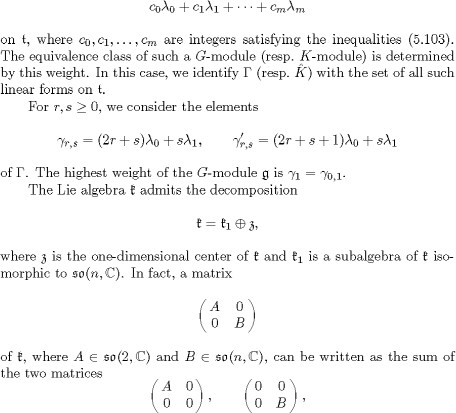
which belong to ![]() and
and![]() respectively. The complexification
respectively. The complexification ![]() of
of ![]() admits the decomposition
admits the decomposition
![]()
where ![]() and
and ![]() are the eigenspaces of the endomorphism Ad j of p corresponding to the eigenvalues +i and -i, respectively. Since j belongs
to the center of K, this decomposition of p is invariant under the action of K on p. We thus obtain the K-invariant decomposition
are the eigenspaces of the endomorphism Ad j of p corresponding to the eigenvalues +i and -i, respectively. Since j belongs
to the center of K, this decomposition of p is invariant under the action of K on p. We thus obtain the K-invariant decomposition
![]()
![]()
We consider the subgroup
![]()
of G, which we introduced i![]() n 3 and which contains the subgroup K. The decomposition (5.104) gives us the
n 3 and which contains the subgroup K. The decomposition (5.104) gives us the ![]() invariant decomposition
invariant decomposition
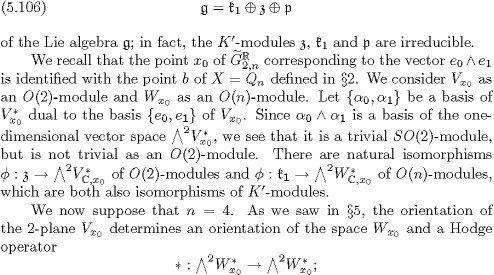
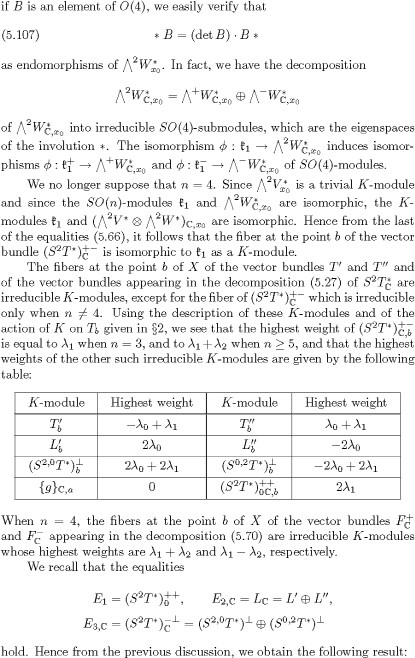
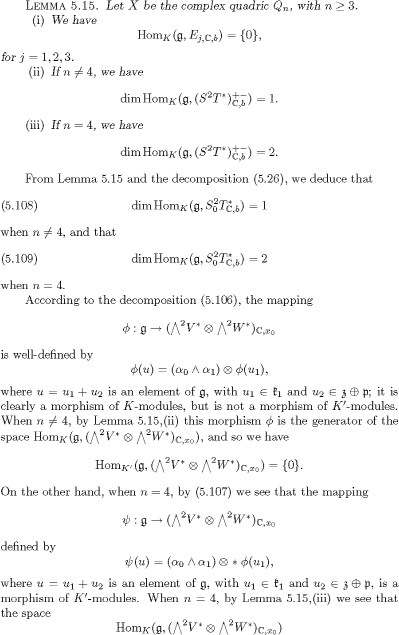
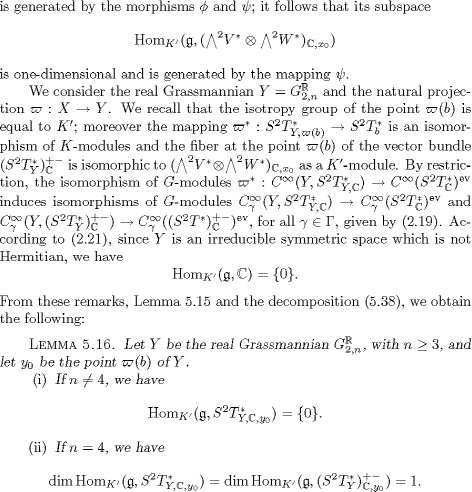
According to the equalities (5.108) and (5.109) and Proposition 2.40, since the symmetric space X is irreducible and is not
equal to a simple Lie group, we see that E(X) vanishes when n ![]() 4, and that E(X) is isomorphic to the G-module
4, and that E(X) is isomorphic to the G-module ![]() when n = 4. By Lemma 5.15 and the Frobenius reciprocity theorem, we see that
when n = 4. By Lemma 5.15 and the Frobenius reciprocity theorem, we see that
![]()
if n ![]() 4, then Lemma 5.15 tells us that
4, then Lemma 5.15 tells us that ![]() is an irreducible G-module.
is an irreducible G-module.
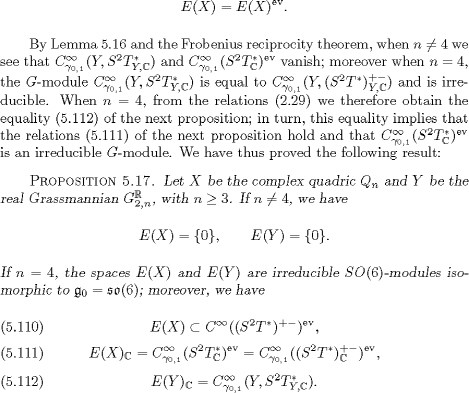
When ![]() the vanishing of the space E(X) is also given by Theorem 1.22 (see Koiso [41] and [42]).
the vanishing of the space E(X) is also given by Theorem 1.22 (see Koiso [41] and [42]).
From the branching law for G = SO(n + 2) and K described in Theorems 1.1 and 1.2 of [54], using the computation of the highest weights of the irreducible K-modules given above we obtain the following two propo-sitions:

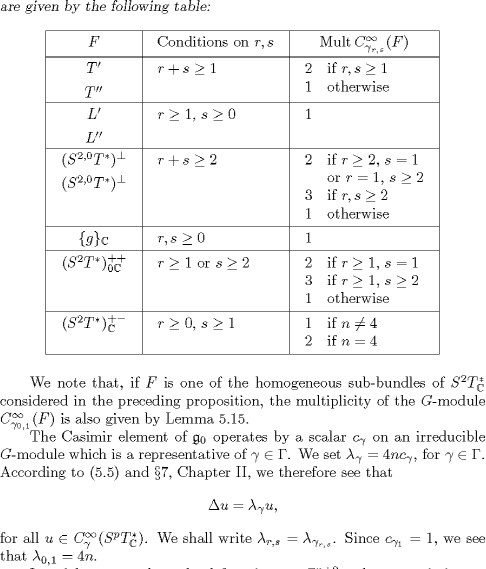

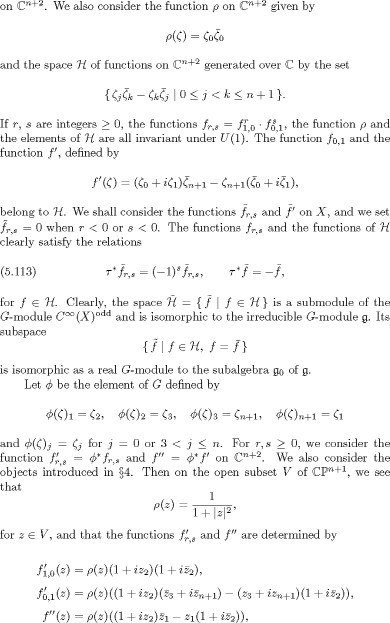
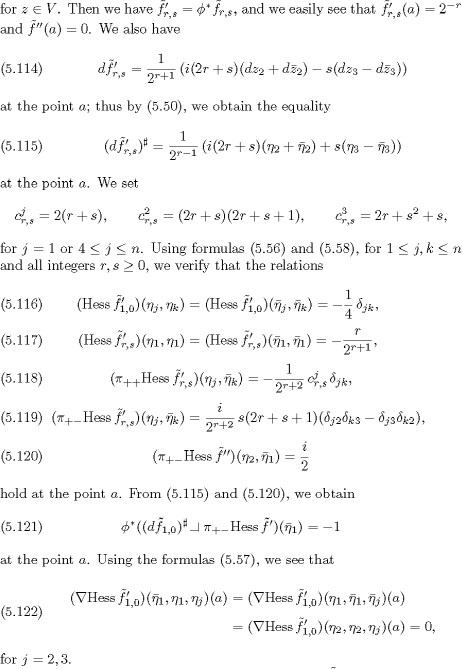
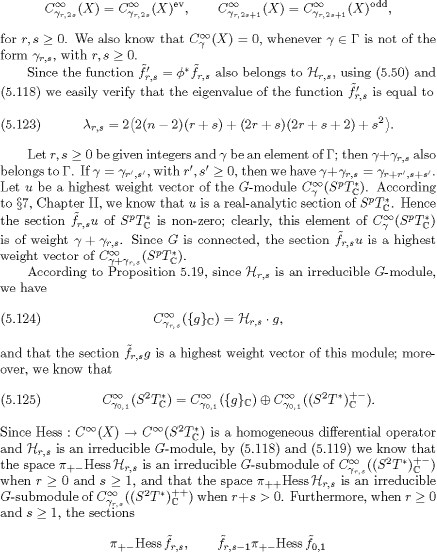
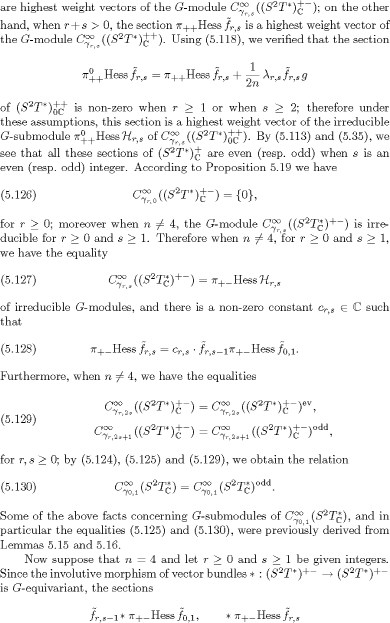
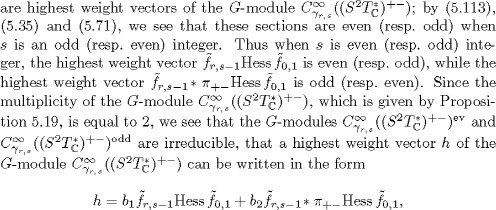
where b1, b2 are complex numbers which do not both vanish, and that there is a non-zero constant ![]() such that the relation (5.128) holds. From these remarks, we obtain the following equalities among irreducible G-modules
such that the relation (5.128) holds. From these remarks, we obtain the following equalities among irreducible G-modules
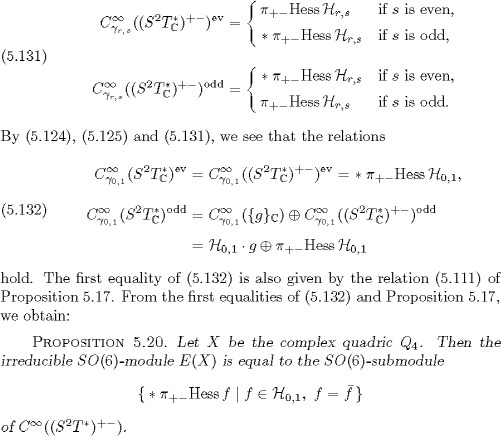
We no longer assume that n = 4 and return to the situation where n is an arbitrary intege![]() r 3. Since Hess
r 3. Since Hess ![]() is a
is a
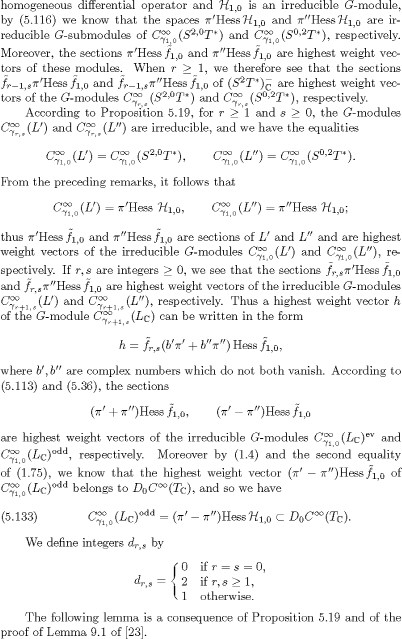


![]() 8. Vanishing results for symmetric forms
8. Vanishing results for symmetric forms
This section is mainly devoted to results concerning the sections of the vector bundle L and to the proofs of the following two results:
PROPOSITION 5.26. Let X be the complex quadric ![]() with n
with n![]() 3. A section h of L over X, which satisfies the relation div h = 0, vanishes identically.
3. A section h of L over X, which satisfies the relation div h = 0, vanishes identically.
Theorem 5.27. Let X be the complex quadric ![]() with n
with n![]() 3. An even section of L over X, which belongs to the space
3. An even section of L over X, which belongs to the space ![]() vanishes identically. Moreover, we have the equality
vanishes identically. Moreover, we have the equality
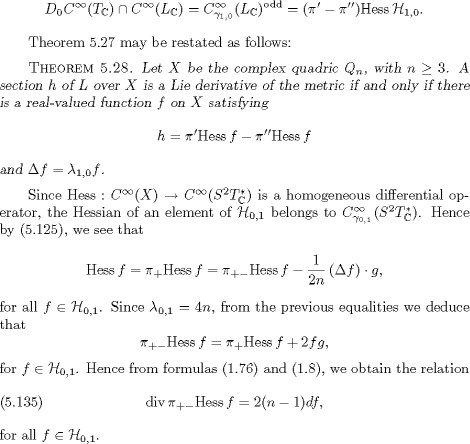
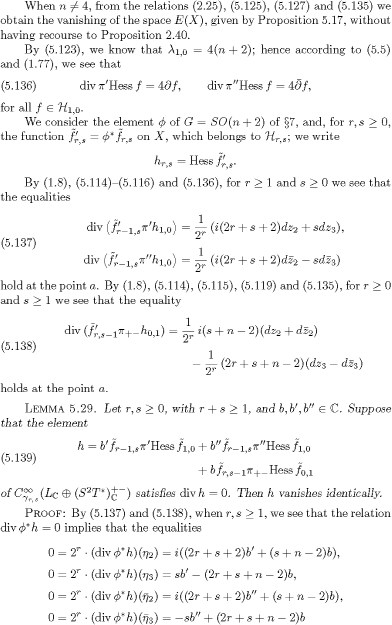
hold at a. Since the determinant of the matrix

is positive, when r, s ![]() 1 the coefficients
1 the coefficients ![]() band b vanish, and so in this case h vanishes. Since
band b vanish, and so in this case h vanishes. Since
![]()
when either r = 0 or s = 0, by (5.138) and (5.139) we see that the relation div ![]() = 0 implies that h vanishes.
= 0 implies that h vanishes.


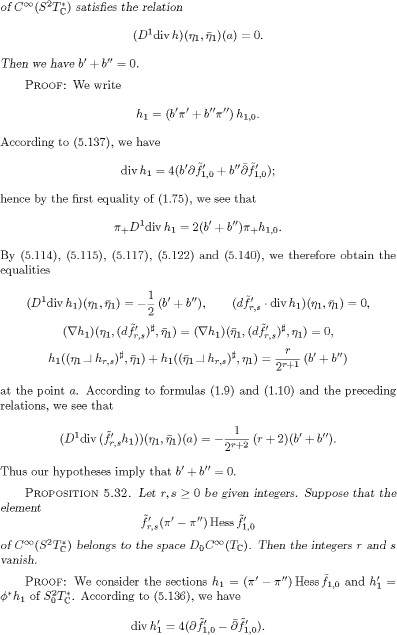
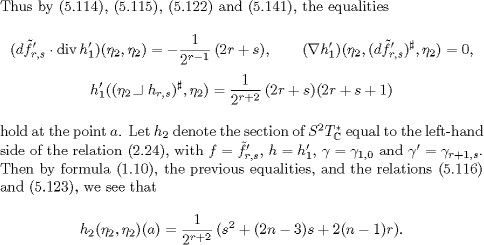
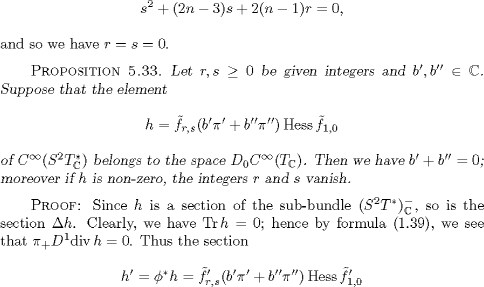
satisfies ![]() From Proposition 5.31, we therefore obtain the relation
From Proposition 5.31, we therefore obtain the relation ![]() According to our hypothesis,
According to our hypothesis, ![]() hbelongs to the space
hbelongs to the space ![]() and so the other assertion of the proposition is a consequence of Proposition 5.32.
and so the other assertion of the proposition is a consequence of Proposition 5.32.
Let ![]() 0 be given integers. According to Proposition 5.33 and the description of the highest weight vectors of the G-module
0 be given integers. According to Proposition 5.33 and the description of the highest weight vectors of the G-module ![]() given above, we see that the space
given above, we see that the space

Since D0 is a homogeneous differential operator, by Proposition 5.18 and the relations (2.1) and (5.133), we see that Theorem 5.27 is a consequence of these results.
![]() 9. The complex quadric of dimension two
9. The complex quadric of dimension two
We endow the manifold ![]() with the Kahler metric which is the product of the metrics
with the Kahler metric which is the product of the metrics ![]() on each factor. It is well-known that the Segre imbedding
on each factor. It is well-known that the Segre imbedding
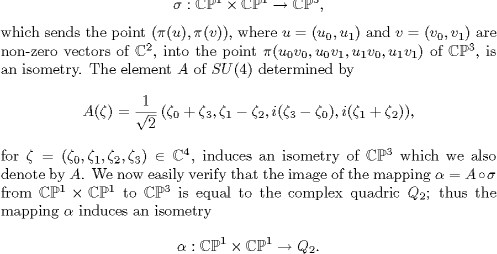
We consider the involutive isometry![]() of
of ![]() defined in
defined in ![]() 4, Chapter III; according to the commutativity of diagram (3.26), it sends the point
4, Chapter III; according to the commutativity of diagram (3.26), it sends the point![]() where
where ![]() is a non-zero vector of
is a non-zero vector of ![]() into the point
into the point ![]() where
where ![]() is a non-zero vector of
is a non-zero vector of ![]() orthogonal to u. We easily verify that the diagram
orthogonal to u. We easily verify that the diagram

is commutative.
Now we consider the diffeomorphism ![]() defined in 5 and the involutive isometry
defined in 5 and the involutive isometry ![]() of
of ![]() defined in
defined in![]() 1, Chapter IV, which sends an oriented 2-plane of
1, Chapter IV, which sends an oriented 2-plane of ![]() into its orthogonal complement endowed with the appropriate orientation. If
into its orthogonal complement endowed with the appropriate orientation. If ![]() is the involutive isometry equal to the composition
is the involutive isometry equal to the composition ![]() the diagram
the diagram
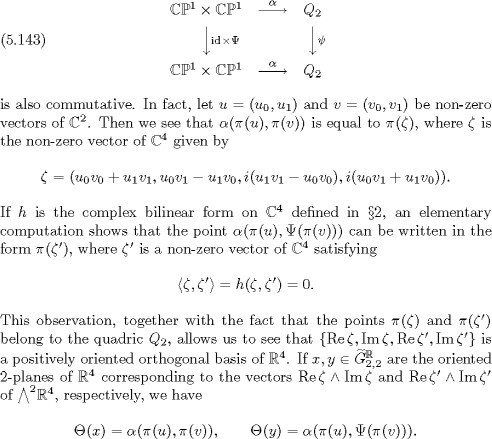
The commutativity of the diagram (5.143) is now a consequence of the relations![]()
![]()
